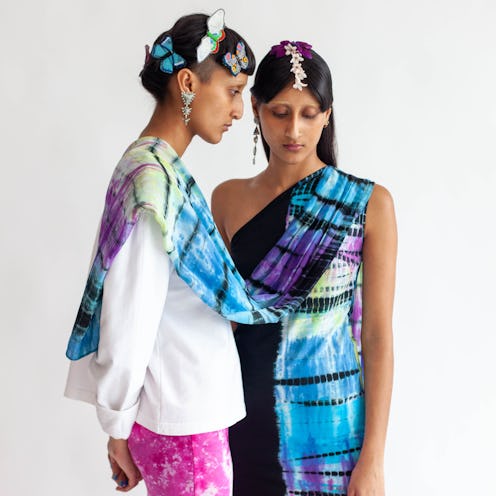
Sheena Sood, designer and founder of sustainable brand Abacaxi, was growing bored with fashion. It seemed like everyone subscribed to the same set of design rules. So, she decided to break the mold. "I felt the desire to start my own label because I wanted to set aside some of the color and fashion ‘rules’ that often come along with working in the industry," she tells Bustle. "I also wanted to highlight these traditional textile crafts in an exciting and different way.”
Exciting and different is an understatement. After studying visual art at Brown University, and then a stint as an assistant and print and textile designer in New York City, Sood launched her first creative project to great acclaim. “I made a capsule of silk dresses and blouses, and appliquéd these vintage embroidered patches I had collected while traveling in Rajasthan." It was a hit.
The young label quickly garnered attention and accolades from fashion editors and Instagram influencers alike. In September 2020, Abacaxi was recognized as one of Teen Vogue’s Generation Next Designers, an honor that celebrates emerging design talent.
“It feels like an exciting time to be a woman of color designer because the fashion industry is finally starting to realize there is room for diverse voices, faces, and perspectives,” Sood shares, acknowledging the barriers she faced as a queer, Indian-American designer.
“In the past, it has been a challenge as I sometimes felt overlooked. The other big challenge for me was starting a brand when I hadn’t seen anyone who looked like me do so here in the U.S.”
Her Fall 2020 collection, titled “The Butterfly Effect,” is an homage to naturally occurring Turing patterns, such as orchid petals, butterfly wings, peacock feathers, snakeskin, and leopard spots. The designs emulate these visual references through a kaleidoscope of tie-dyes and embroidered quilting. Given these influences, it’s not surprising that Abacaxi — the Portuguese word for pineapple — merges a vibrant tropical spirit with the frenetic energy of NYC, where Sood lives.
“For this Fall 2020 collection, I researched Turing patterns, essentially the science behind how patterns and rhythms are formed in nature, and knew I wanted to reflect and abstract them through handmade textiles,” she explains. “‘The Butterfly Effect’ has a climate justice aspect, and is related to the scientific and spiritual concept of the interconnectedness of all human beings on the planet. I like to hide some stories and personal anecdotes or motifs that represent different things to me in many of my pieces.”
One of her go-to items at the moment is the Zebra Quilted Corduroy Coat. “I love the custom zebra-patterned all over embroidery, and the fact that the coat has bright aqua French terry on the inside so it can be worn as a saturated statement coat,” she says. “With a thick poly filling between the two layers of fabric, it’s warm enough for our cold winters here in NYC. I’d style it with the tie-dye turtleneck and tie-dye sharara pants.”
Like most artists, Sood has had to adjust her routine due to the coronavirus pandemic. It’s an ongoing balancing act, but she’s proud of her ability to adapt amid so much uncertainty.
“This year, during quarantine, I’ve learned about resilience and about how much I am really capable of on my own,” she says. “I’m proud of the way I was able to quickly pivot to making face masks in March, a product that was urgently needed. It started as a one-woman operation — me in my living room — and led to me hiring several female sewers who could keep sewing masks out of their homes in NYC using my fabrics.” It doesn't hurt that her face masks are an Instagram influencer favorite.
Today, her self-care routine is all about listening to how she’s feeling in the present moment. Also key? Implementing new breathing techniques.
“I took a course several years ago where I learned a breathing technique called Sudarshan Kriya, and it honestly helped me in every aspect of my life," Sood shares. "We should learn to take care of ourselves and our mental health the same way we learn every other subject in school.”